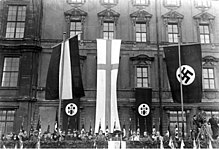Kekristenan Positif
Tampilan


Kekristenan Positif (bahasa Jerman: Positives Christentum) adalah sebuah gerakan di Jerman Nazi yang mencampur gagasan kemurnian ras dan ideologi Nazi dengan unsur-unsur Kekristenan. Hitler menggunakan istilah tersebut dalam Pasal 24[1] dari Wadah Partai Nazi 1920, dengan menyatakan: "Partai mewakili titik pendirian Kekristenan Positif". Karena Non-denominasional, istilah tersebut diinterpretasikan beragam. Sejalan dengan anti-semitisme Nazi, Kekristenan Positif juga menyangkal asal muasal Semitik dari Yesus dan Alkitab. Dalam unsur-unsur semacam itu, Kekristenan Positif memisahkan dirinya dari Kekristenan dan dianggap murtad oleh Katolik dan Protestan.
Bacaan tambahan
- Snyder, L. (1998). Encyclopedia of the Third Reich. Wordsworth Press.
- Steigmann-Gall, Richard (2003). The Holy Reich: Nazi Conceptions of Christianity. Cambridge University Press. ISBN 978-0-521-82371-5.
- Whisker, James B. (1990). The Philosophy of Alfred Rosenberg. Noontide Press. ISBN 978-0-939482-25-2.
Catatan
- ^ NSDAP Party Program. 24 February 1920, Point 24: "We demand freedom of religion for all religious denominations within the state so long as they do not endanger its existence or oppose the moral senses of the Germanic race. The Party as such advocates the standpoint of a positive Christianity without binding itself confessionally to any one denomination. It combats the Jewish-materialistic spirit within and around us, and is convinced that a lasting recovery of our nation can only succeed from within on the framework: The good of the state before the good of the individual." —Robert Michael; Philip Rosen (2007). Dictionary of Antisemitism from the Earliest Times to the Present. Lanham: Scarecrow Press. hlm. 321.

